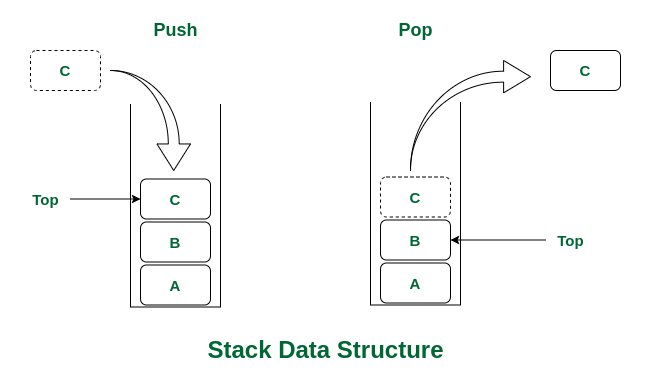A Simple Explanation of Stacks: The Last-In-First-Out Method
 Keerthi Ravilla Subramanyam
Keerthi Ravilla Subramanyam
In our exploration of Data Structures and Algorithms (DSA), we've looked at how different structures work, from arrays to linked lists. Today, we'll focus on other basic fundamental structures stacks. Stacks work on the Last-In-First-Out (LIFO) principle. They are useful in situations where the order of processing is important, like scheduling tasks or managing requests in a server. In this article, we will explore how stacks function, how they are implemented, and the various applications that benefit from their unique characteristics.
What is a Stack?
A stack is a linear data structure that follows the Last In, First Out (LIFO) principle. This means the last element added to the stack is the first one to be removed. You can imagine a stack like a stack of plates: you add new plates on top, and you can only remove the plate from the top. Stacks are used in various applications, such as managing function calls in programming, undo mechanisms in text editors and parsing expressions in compilers. They are typically implemented using arrays or linked lists, with operations like push to add an element, pop to remove the top element, and peek to view the top element without removing it.

Key Operations on Stacks
Push: Insert an element onto the top of the stack. This operation adds a new item to the collection, increasing the stack's size by one. It is crucial for managing data in applications like undo mechanisms in software, where the most recent action must be reversed first
class Stack: def __init__(self): self.stack = [] # Initialize an empty list to store stack items def push(self, item): self.stack.append(item) # Add the item to the top of the stackPop: Remove the top element from the stack and return its value. This operation decreases the size of the stack by one. Just like taking the top plate off a stack of plates, you can remove the element that was added last using this operation. If the stack is empty, attempting to pop an element might result in an error or exception, depending on the implementation.
def pop(self): """Remove the top element from the stack and return its value.""" if not self.is_empty(): item = self.items.pop() # Remove and return the last item from the list print(f"Popped {item} from the stack.") return item else: print("Stack is empty. Cannot pop.") return NonePeek: View the top element without removing it. This operation allows you to see what is on top of the stack without altering the stack's structure. It's useful for checking the top item when you need to make decisions based on the current state of the stack without modifying it.
def peek(self): """View the top element without removing it.""" if not self.is_empty(): top_item = self.items[-1] # Access the last item print(f"Top element is {top_item}.") return top_item else: print("Stack is empty. No top element to view.") return NoneIn this function, if the stack is not empty, it returns the last item in the list, which represents the top of the stack. If the stack is empty, it informs you that there is no top element to view.
isEmpty: Check if the stack is empty. This operation is crucial for determining whether there are any elements in the stack before performing actions like
poporpeek. It helps prevent errors that can occur when trying to access or remove elements from an empty stack. The function typically returns a boolean value:Trueif the stack has no elements andFalseif there are elements present.def is_empty(self): """Check if the stack is empty.""" empty = len(self.items) == 0 if empty: print("Stack is empty.") else: print("Stack is not empty.") return emptySize: Return the number of elements in the stack using the
lenfunction. This gives you an integer representing how many items are currently in the stack. This operation is useful for understanding the stack's current capacity and planning any further actions based on its size.def size(self): """Return the number of elements in the stack.""" current_size = len(self.items) print(f"Current stack size is {current_size}.") return current_size
Advantages and disadvantages of stack
| Advantages of Stacks | Disadvantages of Stacks |
| Simple Implementation: Stacks are straightforward to implement using either arrays or linked lists. | Limited Size: A stack has a fixed size when implemented using an array, which can lead to overflow if the maximum capacity is exceeded. |
| Efficient Memory Usage: Memory allocation for stacks is generally efficient, especially when using linked lists. | No Random Access: Elements in a stack cannot be accessed randomly; they must be accessed in LIFO order. |
| Fast Operations: Both push and pop operations are performed in constant time O(1)O(1)O(1). | Limited Functionality: Stacks support only a limited set of operations (push, pop, peek), making them less versatile compared to other data structures. |
| Useful for Backtracking: Stacks are particularly effective in scenarios that require backtracking, such as maze solving or parsing expressions. | Not Suitable for All Problems: Certain problems may be better solved using other data structures, like queues or trees. |
| Function Call Management: Stacks are essential for managing function calls in programming languages, maintaining the order of execution. | Complexity in Multi-threading: Implementing stacks in a multi-threaded environment can lead to complexities, such as race conditions, if not managed properly. |
Applications of stack
Function Call Management: Stacks are essential for managing function calls and returns in programming. Each function call creates a new execution context that is pushed onto the call stack, and when the function completes, the context is popped off.
Expression Evaluation: Stacks are widely used in evaluating arithmetic expressions, especially in converting infix expressions to postfix (Reverse Polish Notation) and performing the actual computation.
Backtracking Algorithms: Many algorithms, including those for solving puzzles and games, utilize stacks to keep track of previous states or choices, allowing for efficient backtracking when a dead end is reached.
Undo Mechanism in Applications: Applications like text editors and design software use stacks to implement undo and redo functionalities. Each action is pushed onto the stack, allowing users to revert to previous states easily.
Depth-First Search (DFS): In graph traversal, stacks facilitate depth-first search algorithms, allowing the exploration of nodes in a depth-first manner, which is essential for many pathfinding and traversal tasks.
Additional Resources
Conclusion
Stacks are an essential data structure in Data Structures and Algorithms (DSA). Their Last In, First Out (LIFO) principle offers both simplicity and efficiency, making them particularly suitable for scenarios requiring orderly data management, such as function call management and expression evaluation. However, the trade-offs include limitations such as fixed size in array implementations, lack of random access, and restricted functionality, which can affect their applicability in certain situations.
Next, we’ll explore more advanced data structures and concepts, but for now, mastering stacks is a crucial step in understanding the underlying mechanics of many algorithms and systems.
Subscribe to my newsletter
Read articles from Keerthi Ravilla Subramanyam directly inside your inbox. Subscribe to the newsletter, and don't miss out.
Written by

Keerthi Ravilla Subramanyam
Keerthi Ravilla Subramanyam
Hi, I'm Keerthi Ravilla Subramanyam, a passionate tech enthusiast with a Master's in Computer Science. I love diving deep into topics like Data Structures, Algorithms, and Machine Learning. With a background in cloud engineering and experience working with AWS and Python, I enjoy solving complex problems and sharing what I learn along the way. On this blog, you’ll find articles focused on breaking down DSA concepts, exploring AI, and practical coding tips for aspiring developers. I’m also on a journey to apply my skills in real-world projects like predictive maintenance and data analysis. Follow along for insightful discussions, tutorials, and code snippets to sharpen your technical skills.